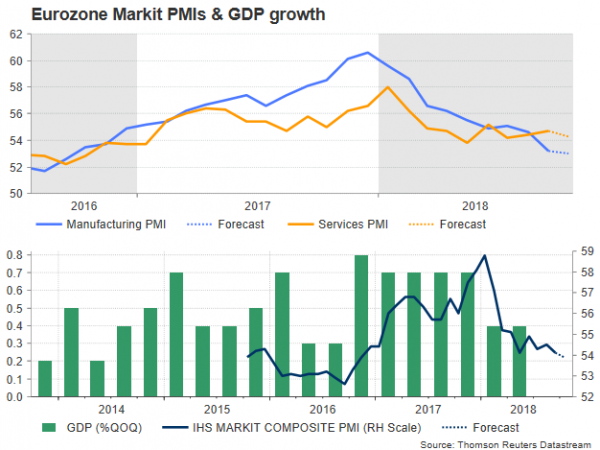The Eurozone will see the release of the flash October PMI survey on Wednesday at 0800 GMT, a day before the European Central Bank (ECB) meets to decide on monetary policy. Consensus is for the data to soften both in the services sector as well as in the manufacturing industry, potentially providing signals that expansion within the single currency area may slow further in the final quarter of the year. (if you want to earning in the currency market use our forex robot)
In September, IHS Markit found that manufacturing activity in the Eurozone was the weakest in two years as new export orders stagnated for the first time since June 2013, driving the Manufacturing PMI down to 53.3. Although anything above 50 indicates growth, the slowdown was enough to prove that uncertainties about whether the UK will have an orderly exit from the bloc, in addition to rising risks from the US-Sino trade war, kept investments under a tight leash in the euro area last month.
In October, sentiment among manufacturers looks to have worsened even further according to analysts, who estimate that the index has slipped to a fresh 2-year low of 53.0, making a rebound towards December’s all-time high of 60.6 appear much more difficult.
Meanwhile in the services sector, where companies hired at the fastest pace since 2007 in September, leading the relative PMI to a three-month high of 54.7, forecasts are also not encouraging. Particularly, the measure is projected to come slightly lower at 54.5 and with manufacturing activity expected to soften as well, the composite PMI which blends the two industries could decline from 54.1 to 53.9, according to projections.
On the monetary policy front, a discouraging PMI report might not affect the ECB plans on Thursday, as the Bank has already informed markets about its intention to keep interest rates steady until the end of the 2019 summer and its decision to terminate the quantitative easing program in December. Even if the ECB is not scheduled to update its economic forecasts at this week’s meeting, ECB members could still translate lower PMI readings into expectations for slower GDP growth in the fourth quarter as the correlation between the two indicators has somewhat strengthened in recent years (see chart). Recall that the expansion rate in the Eurozone continued drifting south for the third straight quarter this year following the pullback off the multi-year peak of 2.8% registered in December. Should the PMI figures show further deterioration in business activities, GDP growth could challenge the ECB’s 2018 growth target of 2.0%.
NOTE: if you do not have time to search for strategies and study all the tools of the trade, you do not have the extra funds for testing and errors – try our Keltner channel forex robot developed by our professionals. Also you can testing in Metatrader our forex auto scalper robot free download .
Turning to FX markets, demand for the euro has been subdued over the past couple of months, with risks around the Italian spending plans and how these would affect Eurozone’s welfare keeping investors away from the market. A downside PMI surprise on Wednesday could harm optimism on eurozone’s economic performance even more and thus reduce positioning in the euro/dollar market. In such case the pair may extend losses towards the 1.1431 bottom first reached on October 9, while a bigger disappointment may also open the door for the 1.1400 round level. Below that, support could run down to the 1.1300 bottom.
In the alternative scenario, a data beat could lift the price up to 1.1500 where the 61.8% Fibonacci of the downleg from 1.1621 to 1.1431 is placed. Moving higher, the area between the 50% and the 61.8% Fibonacci levels of 1.1526 and 1.1548 respectively would be in focus before attention turns to the 1.1621 top.
For traders: We recommend you odin forex robot free download for test in mt4 or our best Portfolio of forex robots


 Signal2forex.com - Best Forex robots and signals
Signal2forex.com - Best Forex robots and signals




